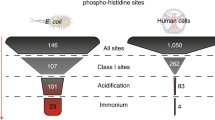Abstract
Protein phosphorylation on histidine occurs in a large number of processes in prokaryotes and in an unknown number of processes in eukaryotes. The functions of protein phosphohistidine in prokaryotes are much more clearly understood (1,2. The methods presented here have been developed for the study of protein histidine phosphorylation in eukaryotes where phosphohistidine is found as an intermediate in some enzyme reactions and may also be involved in signaling mechanisms (3). In prokaryotes, two types of protein phosphorylation on histidine have been characterized in detail. The first, historically, is the phosphoenolpyruvate-sugar phosphotransferase system (4,5). In this system, phosphohistidine acts as a phosphate donor and the initial phosphate donor is phosphoenolpyruvate, so this is not a protein kinase system. The second prokaryotic system is the twocomponent regulatory system (1,2). The core of this system comprises three protein domains, which may or may not be on different polypeptides. The first domain is the protein kinase domain, the second is the histidine substrate for this kinase and the third contains an aspartate residue that removes the phosphate from phosphohistidine. Genes homologous to those of the two-component system have been identified in lower eukaryotes (1,6,7).
Similar content being viewed by others
References
Alex L. A. and Simon M. I. (1994) Protein histidine kinases and signal transduction in prokaryotes and eukaryotes. Trends Genetics 10,133–138.
Swanson R. V., Alex L. A., and Simon M. I. (1994) Histidine and aspartate phosphorylation: two-component systems and the limits of homology. Trends Biochem. Sci. 19,485–490.
Matthews H. R. (1995) Protein kinases and phosphatases that act on histidine, lysine, or arginine residues in eukaryotic proteins: a possible regulator of the mitogen-activated protein kinase cascade. Pharmacol. Ther. 67, 323–350.
Meadow N. D., Fox D. K., and Roseman S. (1990) The bacterial phosphoenolpyruvate:glucose phosphotransferase system. Annu. Rev. Biochem. 59, 497–542.
Postma P. W., Lengeler J. W., and Jacobson G. R. (1993) Phosphoenolpyruvate: carbohydrate phosphotransferase systems of bacteria. Microbiol. Rev. 57, 543–594.
Swanson R. V. and Simon M. I. (1994) Signal transduction. Bringing the eukaryotes up to speed. Curr. Biol. 4, 234–237.
Hughes D. A. (1994) Signal transduction. Histidine kinases hog the limelight [news; comment]. Nature 369, 187–188.
Boyer P. D., DeLuca M., Ebner K. E., Hultquist D. E., and Peter J. B. (1962) Identification of phosphohistidine in digests from a probable intermediate of oxidative phosphorylation. J. Biol. Chem. 237, 3306–3308.
Smith D. L., Bruegger B. B., Halpern R. M., and Smith R. A. (1973) New histone kinases in nuclei of rat tissues. Nature 246,103–104.
Huebner V. D. and Matthews H. R. (1985) Phosphorylation of histidine in proteins by a nuclear extract of Physarum polycephalum plasmodia. J. Biol. Chem. 260, 16,106–16,113.
Huang J., Wei Y., Kim Y., Osterberg L., and Matthews H. R. (1991) Purification of a protein histidine kinase from the yeast Saccharomyces cerevisiae: the first member of this class of protein kinases. J. Biol. Chem. 266, 9023–9031.
Wei Y. F. and Matthews H. R. (1990) A filter-based protein kinase assay selective for alkali-stable protein phosphorylation and suitable for acid-labile protein phosphorylation. Anal. Biochem. 190, 188–192.
Carlomagno L., Huebner V. D., and Matthews H. R. (1985) Rapid separation of phosphoamino acids including the phosphohistidines by isocratic high-performance liquid chromatography of the orthophthalaldehyde derivatives. Anal. Biochem. 149, 344–348.
Santos J., Quach T., Fernandez V., and Matthews H. R. (1997) Histidine Kinase Activity of the Yeast Protein G4p1. FASEB J. 11, A1355.
Crovello C. S., Furie B. C., and Furie B. (1995) Histidine phosphorylation of Pselectin upon stimulation of human platelets: a novel pathway for activation-dependent signal transduction. Cell 82, 279–286.
Hultquist D. E., Moyer R. W., and Boyer P. D. (1966) The preparation and characterization of 1-phosphohistidine and 3-phosphohistidine. Biochemistry 5, 322–331.
Hultquist D. E. (1968) The preparation and characterization of phosphorylated derivatives of histidine. Biochim. Biophys. Acta 153, 329–340.
Pesis K. H., Wei Y. F., Lewis M., and Matthews H. R. (1988) Phosphohistidine is found in basic nuclear proteins of Physarum polycephalum. FEBS. Lett. 239, 151–154.
Wei Y. F. and Matthews H. R. (1991) Identification of phosphohistidine in proteins and purification of protein histidine kinases, in Methods in Enzymology (Hunter T. and Sefton B. W., eds.), Academic, Orlando, FL, pp. 388–414.
Besant P. G. (1998) A chromatographic method for the preparative separation of phosphohistidines. Anal. Biochem., 258, 372–375.
Huebner V. D. (1985) Histidine kinase activity in the nucleus of Physarum polycephalum, Univ. California, Davis, Ph. D. thesis.
Beasant P. and Atwood P. V. (1998) Anal Biochem.265, 187–190.
Editor information
Editors and Affiliations
Rights and permissions
Copyright information
© 2000 Humana Press Inc., Totowa, NJ
About this protocol
Cite this protocol
Matthews, H.R., Chan, K. (2000). Protein Histidine Kinase. In: Reith, A.D. (eds) Protein Kinase Protocols. Methods in Molecular Biology™, vol 124. Humana Press. https://doi.org/10.1385/1-59259-059-4:171
Download citation
DOI: https://doi.org/10.1385/1-59259-059-4:171
Publisher Name: Humana Press
Print ISBN: 978-0-89603-700-7
Online ISBN: 978-1-59259-059-9
eBook Packages: Springer Protocols



